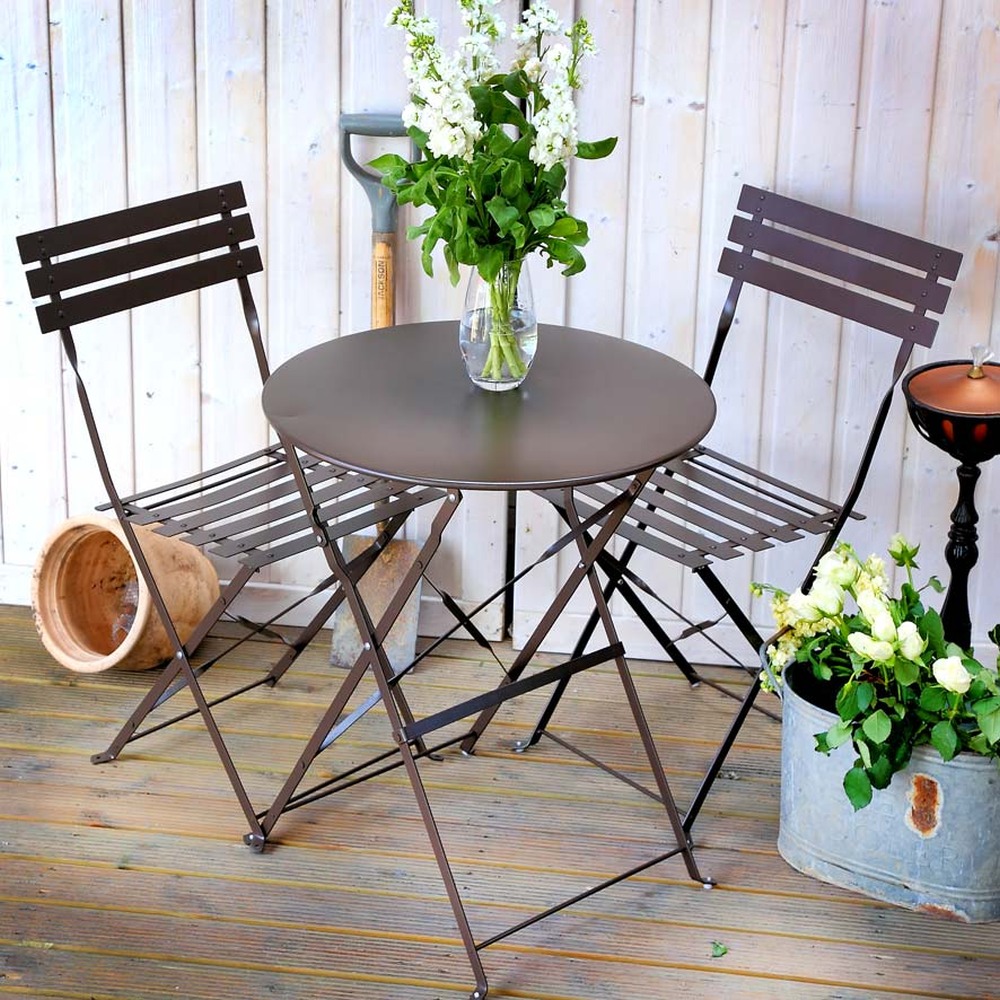We recently took a detailed look at small balcony furniture and we thought it would be nice to follow that article up with some helpful style tips. Our guide to balcony furniture was very much focussed on their popularity in UK homes, on social media, and we looked in detail at the different types of furniture and how to choose the right set or pieces.
Styling a balcony with small garden furniture pieces and decor can be tricky though. It requires a thoughtful and space-efficient approach to make the most of the available area. Of course, first and foremost we want our outdoor spaces to look good, and reflect our sense of style, but we also need them to function, creating a place to spend time and get maximum enjoyment.
Designing a compact balcony will always present challenges, just like it will with a small room inside the home. However, with a little careful planning and creativity, we can make the most of the space, no matter how limited it is in terms of dimensions.
Just remember that each balcony is unique too, and personal preferences play a significant role in the design process. Don’t be afraid to experiment with different layouts and furniture arrangements until you find a solution that works best for your needs and outdoor area.
The Lazy Susan team have compiled what we think are the 5 most helpful decorating tips you need to apply when styling your outdoor space with Small Balcony Furniture.
1. The right type of balcony furniture is key
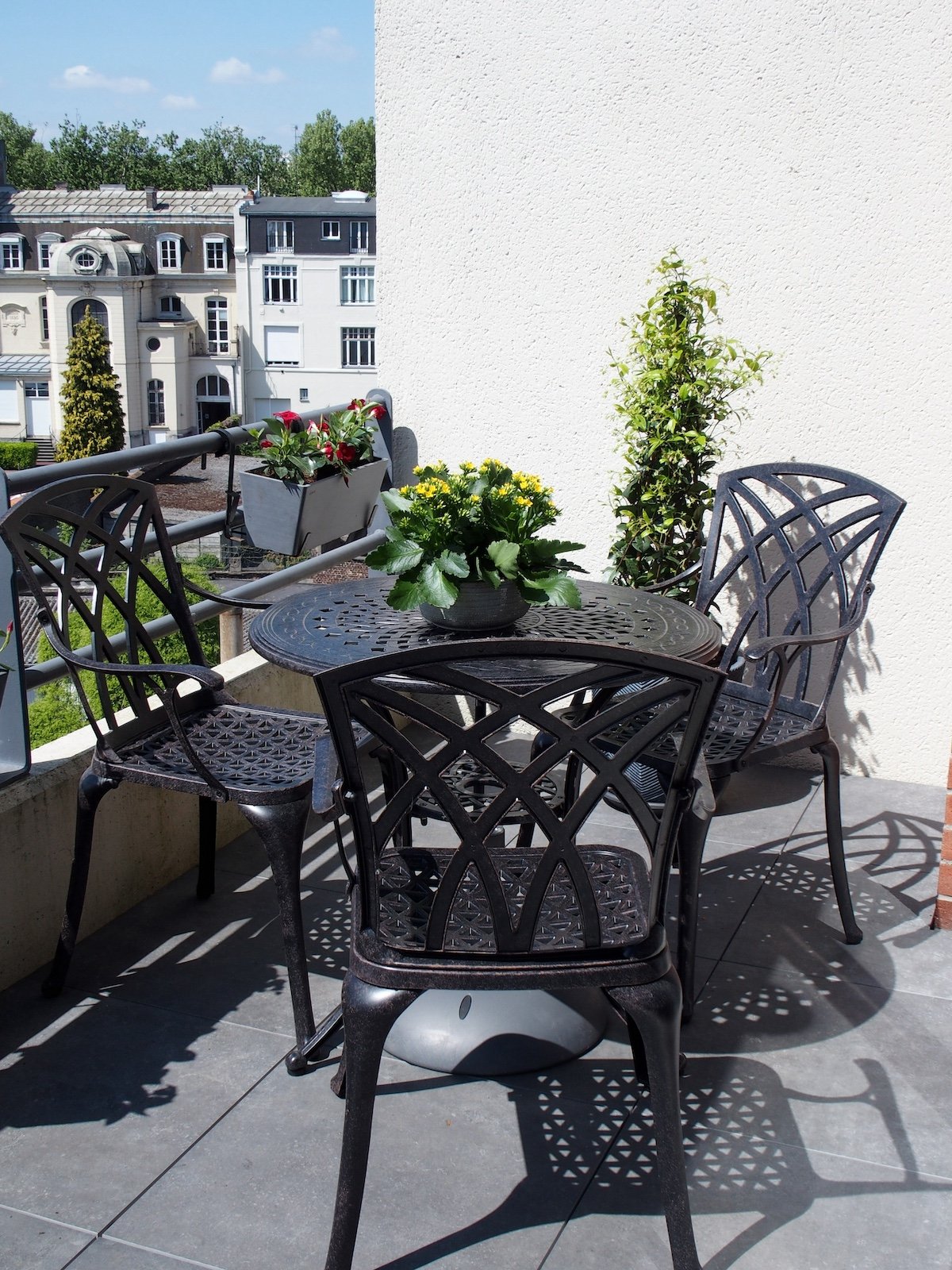
When we talk about type, we are referring to the purpose of the furniture. For example, is it a bistro set for intimate dining or a 2-seater outdoor sofa for relaxing?
There is a wide choice of small-scale outdoor furniture in durable materials that are perfectly suited for balcony use, and the key is to look for compact garden chairs, tables, benches, etc that fit well without overwhelming the space.
Start by measuring the available space on your balcony. Please take note of the dimensions, including length, width, and any architectural features that may impact furniture placement and its functionality when in situ.
Think about how you like or want to use the space and establish the primary function of your balcony. Do you want a cosy reading nook, an intimate dining area, or an outdoor lounge space?
The intended use will guide the types of furniture that best fit for function. Choosing the right balcony furniture is crucial for creating a comfortable, practical, and visually appealing small space, so look for pieces or sets that fit the scale of your balcony and will get the most use.
In small spaces, you could opt for compact or foldable furniture to maximise the available area without overwhelming the space.
Alternatively, you could consider furniture that serves multiple functions. For example, a storage ottoman that doubles as a coffee table or a garden bench with built-in storage.
Foldable bistro tables and chairs such as our Alessia (above) can be easily unfolded when needed. This allows you to have a dining or seating area without sacrificing space when not in use.
The style of the furniture is also important, and our advice would be to go for furniture made from lightweight materials like cast aluminium or plastic resin.
Balconies are often sufficiently sheltered from the wind and lightweight pieces are easier to move and rearrange as needed.
Also, look for outdoor tables and chairs with a slim profile and avoid the bulky or oversized patio furniture that could make your balcony feel cramped.
You want furniture that is proportionate to the size of the balcony and makes the most of the available space without overwhelming it. The organic lines and delicate metalwork of our collection, for example, will help to create a sense of openness in a small space.
Whilst balconies are often quite sheltered, they are still open to the elements, so the materials it is made from need to fit for purpose too. Weather resistance is critical, and you want furniture that is both UV and water-resistant.
It is also important to consider the maintenance requirements of the furniture. You want a material that is easy to clean and resistant to fading, rust, and other weather-related issues.
By considering these factors when decorating, you can choose the right type of small balcony furniture that not only fits with how you like to spend time outside but also enhances the overall style.
2. Be strategic about the balcony layout
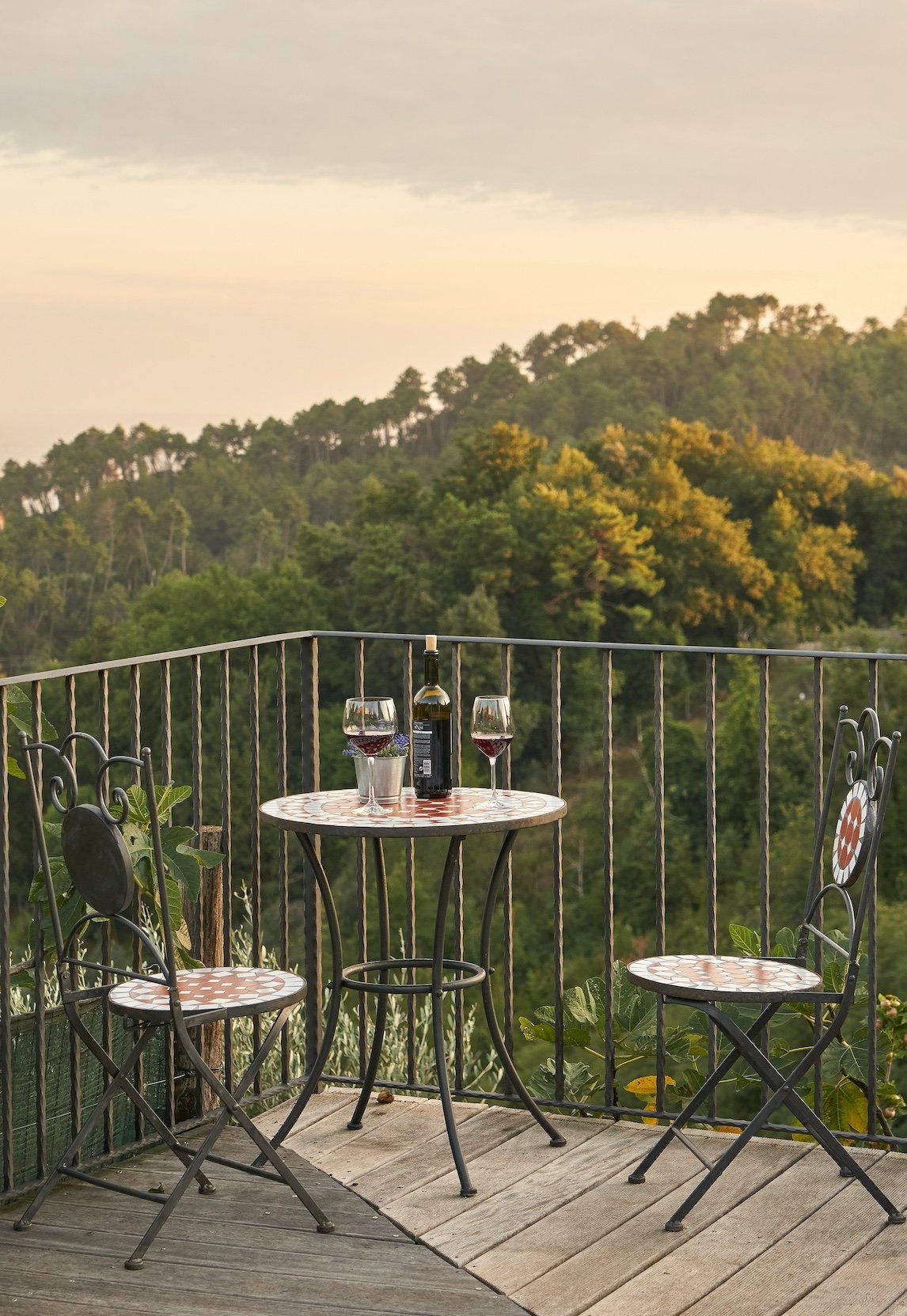
When decorating a small space such as a balcony, it is essential we carefully plan what we put on the balcony and where to put it so we can maximise functionality and create a sense of openness.
One of the best ways to make the best use of the space is to divide the balcony into functional zones based on your needs, such as a seating area, a planting area, and an intimate dining area.
It is also important to select furniture that is proportionate to the size of the balcony. Avoid large, bulky pieces that can make the space feel cramped. Opt for sleek, streamlined furniture with tall legs such as our bistro sets to create a sense of openness.
A simple designer's trick is to move the furniture away from walls to create a more open and airy feel. You don’t need much (and the temptation is often to push things up against the wall) but a little bit of space tricks the eye into thinking there is more.
You should also leave enough space between furniture pieces to allow for easy movement and function. Less is more and a compact space will often be better with several smaller pieces that serve multiple functions.
One of the best ways of saving space without sacrificing functionality is by choosing pieces or sets that be easily folded or stacked when not in use. This includes folding chairs, drop-leaf tables, or nesting tables that can be stored away to free up space.
Keep your balcony clutter-free too, as a clean and organised space will feel larger and more comfortable.
Carefully arrange furniture to allow for easy movement and avoid positioning any furniture so that it blocks access. You want clear pathways and space to sit comfortably, etc.
Balconies often have walls too, so when it comes to decorating and/or positioning furniture, use them if you can.
Whilst often there for privacy, safety, shelter and shade, they also provide the perfect opportunity to personalise and optimise the use in that space.
Walls provide the perfect surface for vertical gardening, for example, and depending on the material, you can hang planters, trellises, and wall-mounted shelving for plants and flowers.
If you can’t affix anything to the walls, then you can position furniture and decor items such as freestanding shelving or tall planters to bring some interest to the space.
Walls can also be designed to integrate various features that make the best use of the space, such as built-in seating, storage, or lighting fixtures. This will again help to maximise the functionality of your balcony space and enhance usability.
By carefully considering the layout, size, and functionality of each piece, you can create a well-organised and visually appealing balcony that feels open, and comfortable, and uses the space you have most efficiently.
3. Build layers on your balcony for visual interest
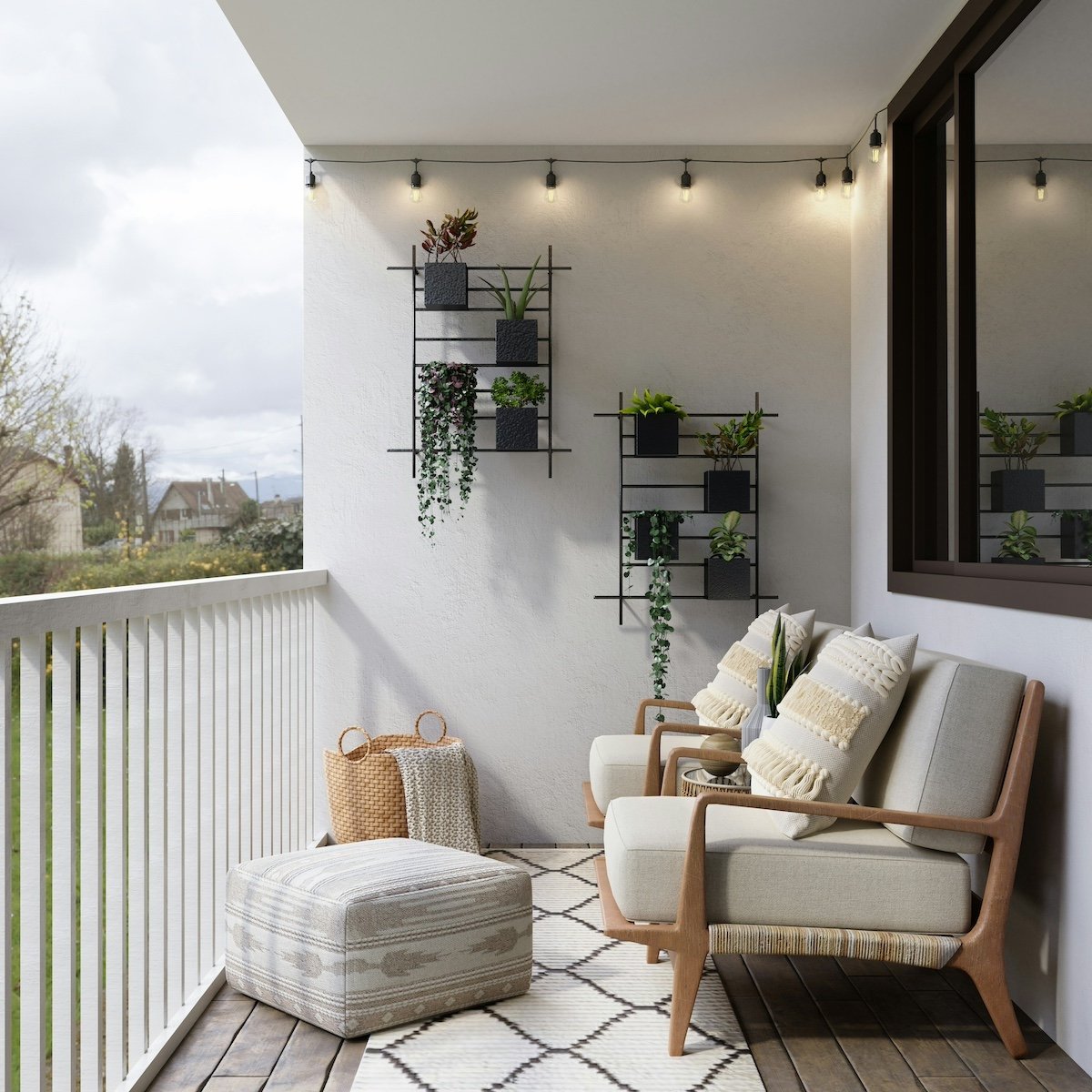
In balcony design (or all forms of small garden and patio design for that matter), layers are a great way to add depth, interest, and functionality.
Simple items such as outdoor rugs, cushions, and throw blankets will not only up the comfort of small furniture pieces but also make the space look more inviting.
Layers introduce visual interest to your balcony by adding different textures, patterns, and colours. They break up the monotony, soften the edges, and create a more appealing and engaging environment.
If space is limited then layers can help to add greater depth and dimension, tricking the eye into making your balcony furniture fit better and the overall space feel more cohesive.
They are not just aesthetic, layers can serve functional purposes too. For example, using curtains will not only add a decorative element but also provide shade and privacy.
Similarly with furniture, by adding additional elements such as clever storage solutions or multifunctional pieces, you are contributing to the overall practicality of the space.
Good layering when done right will help create a sense of balance and harmony on your balcony, and by balancing different elements such as contrasting colours, textures, or materials, you will pull together a design scheme that not only looks good but pulls the whole space together.
We talk a lot about how important flow is when designing the layout of a balcony, patio or garden. Layers are a great way of creating a seamless transition between different zones or from the inside of the home to the out.
This works particularly well if the balcony is part of a more open-style concept, whereby you want the outside living space to simply be an extension of the indoor and vice versa. They are one space in look and feel, connected, separated by glass, but their own space too.
Think about how you arrange your furniture in a way that creates depth, visual interest, and functionality. Start by identifying the primary functions of the space.
Establish a focal point on your balcony, This could be the furniture itself, a statement planter, or the view beyond. Arrange furniture around this focal point to create a sense of balance and draw attention to your outdoor space.
By incorporating pieces of balcony furniture in varying heights you will also add visual interest. For example, mix low-profile furniture like a bistro set with a taller item such as a vertical planter to create a dynamic and visually appealing composition.
You can balance a balcony by using both symmetrical and asymmetrical arrangements. Symmetry can provide a sense of order, while asymmetry adds a more casual and eclectic feel.
Group your balcony furniture based on function. For example, arrange seating around a coffee table to create a conversational area. Clustering furniture with a purpose helps to define different zones.
Don't be afraid to experiment with different arrangements. Move furniture around the balcony until you find a layout that feels comfortable, looks good and makes the best use of the space.
Consider the scale of the furniture in relation to the size of the balcony, and remember that the key to successful furniture layering is finding a balance between functionality and style.
4. Bring in greenery to complement your balcony furniture
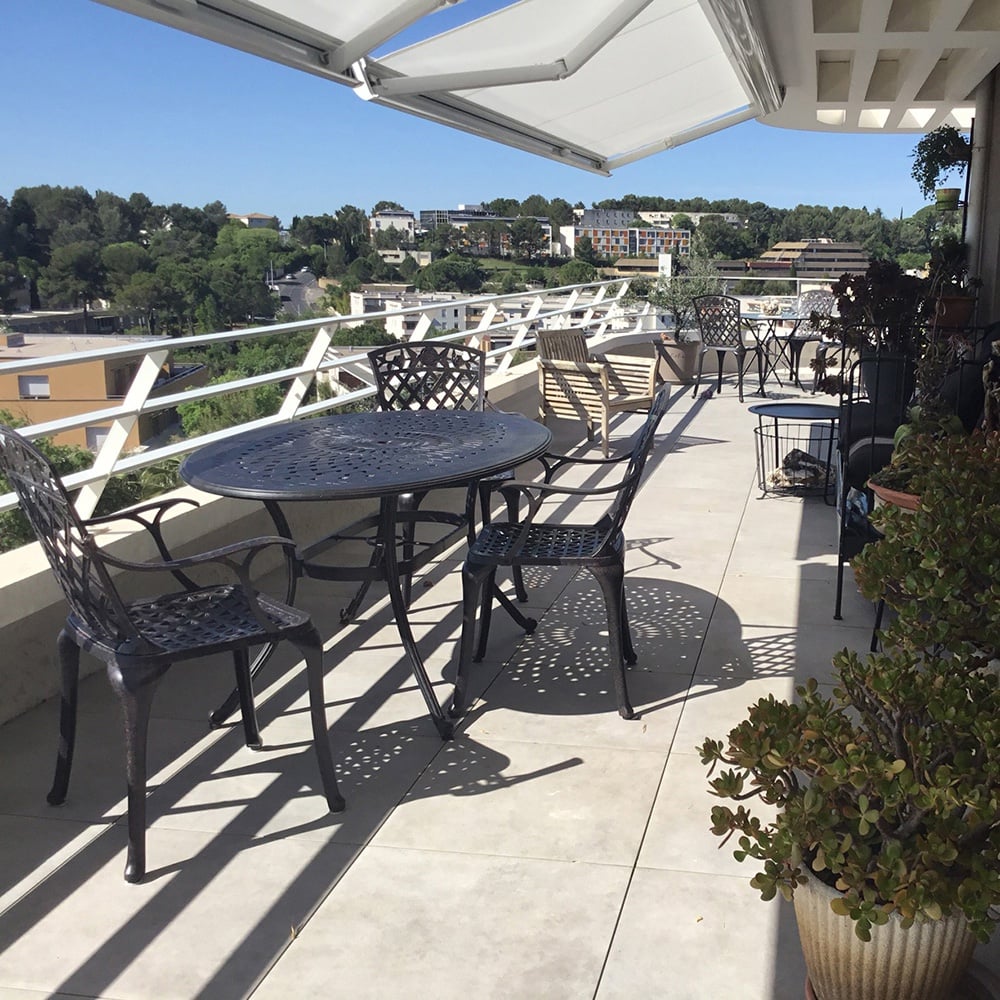
For us, the planting you place around your balcony furniture is just as important as the furniture itself. No matter how small the space is, we think it is vital you introduce a little Mother Nature.
Greenery brings a natural and refreshing element to your balcony, enhancing both the look and feel. Plants introduce colour and texture and they will transform a plain or utilitarian space into one that is bursting with life.
Whilst the right type of furniture, positioned in the right way will enhance the functionality, planting is what will make the space a joy to sit and spend time in.
Having plants on your balcony will create a more relaxing and calming atmosphere, but as well as looking beautiful, they too can serve a function.
Strategically placing plants around your furniture can act as a natural screen, providing privacy and shielding your seating area from neighbours and the sun and wind.
Tall plants such as Bamboo, tall grasses like Miscanthus, and tall ferns like the Kimberly Queen or climbers such as Jasmine, Clematis, and Bougainvillea in containers will create a more secluded and intimate space.
Plants will contribute to temperature regulation on balconies that are a bit of a sun trap (common on balconies). It creates natural shade, reducing the direct impact of sunlight and making the space more comfortable.
Do a little research and look for species that are easy to maintain but will thrive in a balcony environment.
You could opt for plants that have air-purifying properties, great if you live in an urban environment. Alternatively, plant to attract wildlife or grow your own herbs, vegetables, or even small fruit-bearing plants.
The advantage of low-maintenance balcony-friendly plants is their suitability for container gardening, making it easier for those with a less-than-green thumb to enjoy the benefits without extensive horticultural flair.
A balcony garden fosters a sense of connection with nature, even in urban environments.
You can use planting to frame and accent your balcony furniture, create depth and layers, create interest with vertical and hanging solutions or accessorise your outdoor space by placing suitable planters at the centre of your outdoor table.
5. Choose the right colour scheme for your outdoor furniture
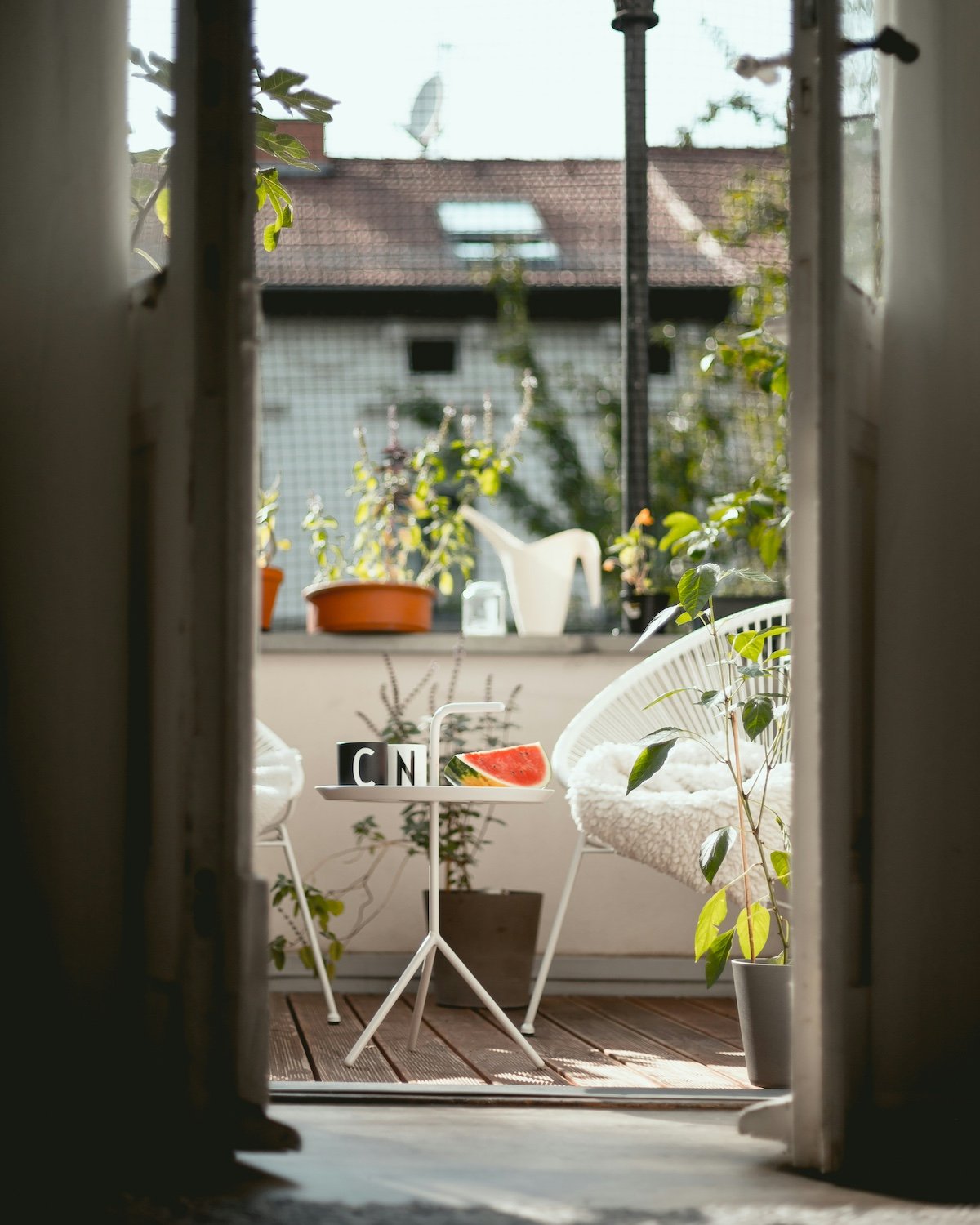
The colour choices for balcony furniture are often limited to provide a neutral base from which you can build (and colour is best introduced via fabrics, planting, accessories, etc).
However, the impact of a dark finish such as our Black with Antique Bronze and our White painted finishes can have a dramatic impact on a smaller space, as can the wider colour scheme.
For example, light colours, especially neutral tones, will help to make a small balcony feel larger and more open.
Choosing the right colour scheme will not only significantly impact the perception of space but also the ambience and atmosphere.
However, too much light and things can become lost, so it is a very fine line.
White reflects light and creates a sense of openness, making a small balcony feel brighter, airier, and bigger. Introduce white furniture and it could also become lost so a contrast might be a better option.
You can also keep things light but break up white space with light neutral shades of beige, grey, or pastel colours. This won’t impact the feeling of spaciousness you’re trying to achieve but will just help to provide a subtle backdrop.
Soft blues and greens evoke a sense of calm and can make a small balcony feel more serene. These colours tend to recede visually, creating an illusion of depth too.
On the flip side, darker colours can be used if you want to make your balcony feel cosy and create a more intimate atmosphere.
Just remember that there are no strict rules when it comes to a colour scheme, and personal preference must also play a significant role in the colour scheme you choose.
The best thing to do is experiment before you commit. If you like our small balcony furniture range, then order one of our free Sample Kits, get some paint tester pots, and see how it all looks in different lighting conditions and against the backdrop of your balcony.
Ultimately, the colour scheme that you go for must look good, bring you joy, work in the space, fit with the rest of your home, and create a comfortable and inviting outdoor living space.
Simplicity is key when styling a balcony with small outdoor furniture. Focus on functionality, comfort, and personal style to create an inviting and enjoyable space within the constraints of a smaller area.
When decorating any small space, be it a balcony, patio or a room inside the home, try and make the best use of all of that space. Think about how you will move on to and in it and arrange furniture to best optimise functionality.
By carefully planning your balcony layout, you can create a functional, aesthetically pleasing, and enjoyable outdoor space that suits your lifestyle and preferences.
Don’t be afraid to experiment with different arrangements and be open to adjusting the layout as needed to optimise the use of your balcony.
If you have any photos of your new Small Balcony Furniture from Lazy Susan, we’d love to see a few for our Do Some Good charity campaign. You can tag us @LazySusanFurniture on Instagram or Facebook or Upload Here.
Related Articles
- The Lazy Susan guide to balcony furniture
Balconies have become a popular architectural feature on UK homes, so we’re taking an in-depth look at how to measure, choose, style and maintain balcony furniture…
Read More - How to carefully measure for a balcony furniture set
We have a simple 13-step process to help you carefully measure for a balcony furniture set that will save you the hassle of returning a large bulky item that doesn't fit or function…
Read More - Our top 10 balcony furniture ideas for summer 2024
The Lazy Susan team is taking a closer look at our top 10 balcony furniture ideas for summer 2024…
Read More - How do you protect and secure your outdoor balcony furniture?
Our product development team are discussing how to maintain, protect and secure your outdoor balcony furniture…
Read More




